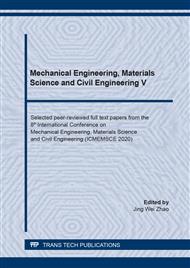p.61
p.69
p.77
p.82
p.87
p.93
p.98
p.103
p.109
Encapsulation and In Vitro Release Test of Flavonoid and Phenolic Compounds Extracted from Watermelon (Citrullus lanatus) Rind: Comparison of Oven and Spray Drying Treatments
Abstract:
The purpose of this study was to determine and compare the effect of oven drying and spray drying treatments on the encapsulation of anthocyanin, flavonoid and phenolic extracted from watermelon rind. The analysis done in this work were as follow: total anthocyanin (TA), total flavonoid (TF) and total phenolic (TPC) content in the supernatant, yield of nanocapsule, Particle Size Analysis, and In Vitro test (test for flavonoid and phenolic release) in the supernatant food. The analysis results showed that the total anthocyanin content in watermelon rind with a spray drying treatment was 0.1113 mg/L, total flavonoid was 0.6159 g/mL, and total phenolic was 0.3410 g/mL. While using the oven, the anthocyanin content was 0.0891 mg/L, total flavonoid was 1.4590 g/mL, and total phenolic was 1.1349 g/mL. As noticed, the total content of anthocyanin resulted by using a spray dryer was greater than by using an oven. However, the total flavonoid and total phenolic resulted by using a spray dryer was smaller than by using an oven. During In Vitro analysis, the results of the release of flavonoid and phenolic resulted by using an oven into the distilled water were much larger and unstable than by using a spray dryer. This is likely because chitosan-Na (TPP) bonds are weak. Additionally, the yield of capsule on the use of spray dryer was 0.6, higher than the use of an oven, which was 0.48. While, the average particle size in the use of a spray dryer was 2.296 μm, smaller than the use of an oven, which was 61.998 μm.
Info:
Periodical:
Pages:
87-92
Citation:
Online since:
June 2021
Authors:
Keywords:
Price:
Сopyright:
© 2021 Trans Tech Publications Ltd. All Rights Reserved
Share:
Citation:


